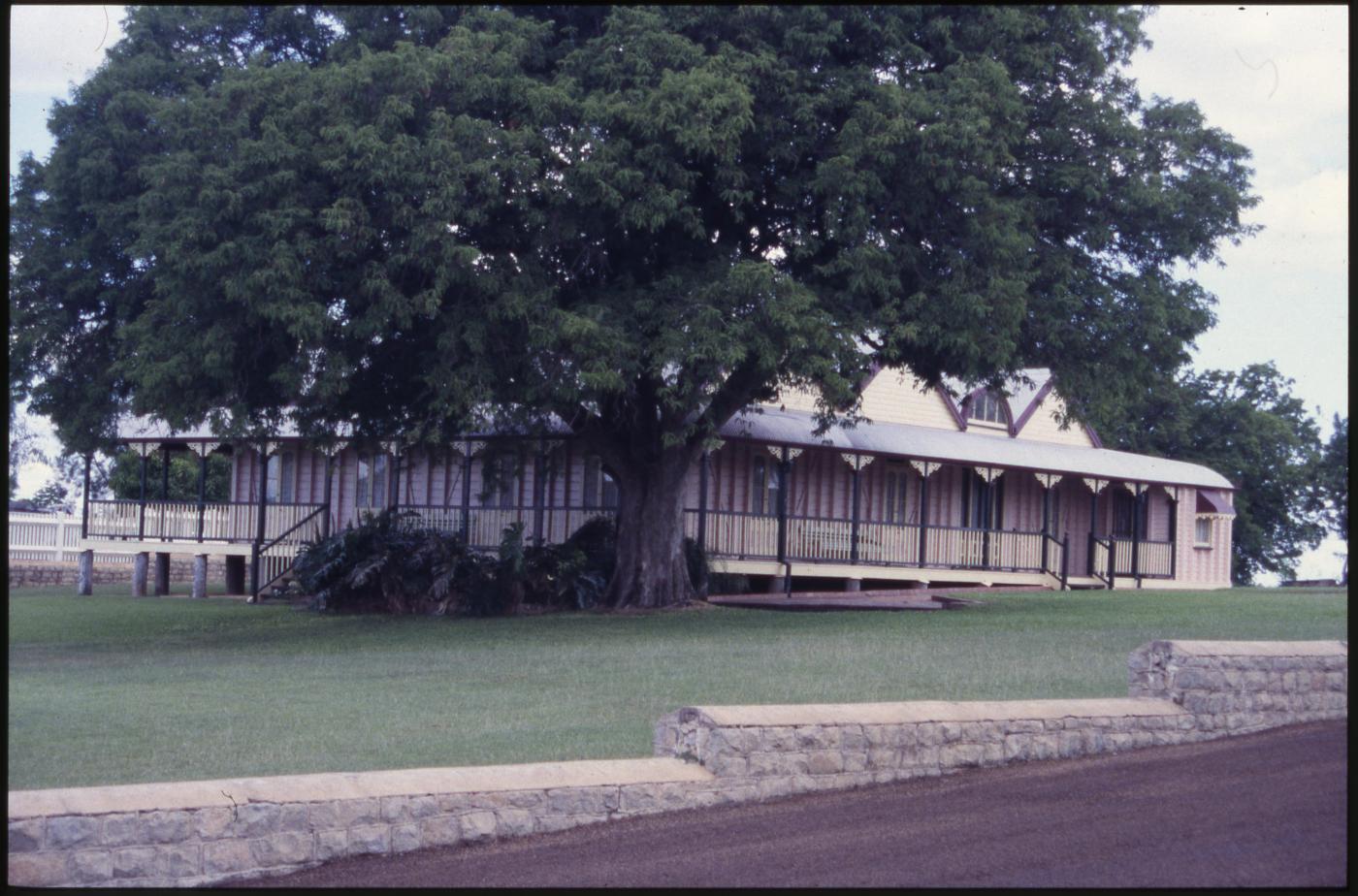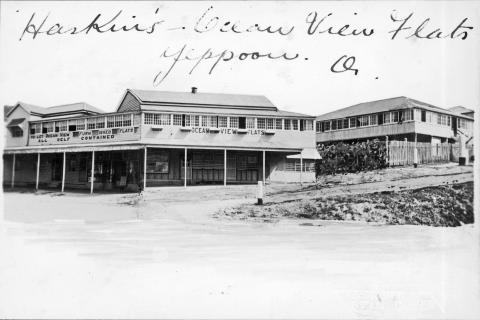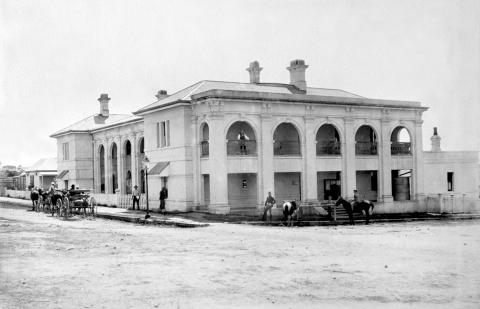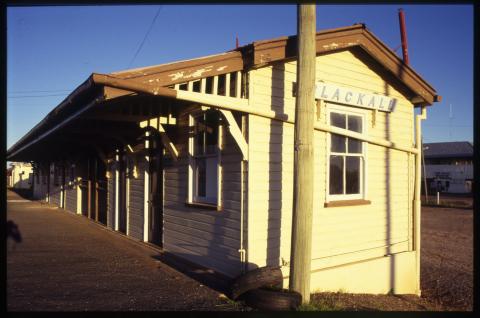
- News of the day
-
Northern Mining Register, Thursday 24 December 1891, page 58
Mr. Frederick Pfeiffer.
Mr. Frederick Pfeiffer, the "boss" Day Dawner, first saw the light in Frankfort on the Maine, in 1834, and is now consequently 57 years of age. When a young man of about 18 years of age, and an apprentice on board ship, he first saw Australia, the vessel on which he was serving his time, bringing a cargo to Fremantle, Western Australia. Thence the vessel returned to Singapore, traded to Siam, back to Singapore, and subsequently to Melbourne. Mr. Pfeiffer left the ship in 1856, being then 22 years of age, and went to seek his fortunes on the gold diggings of Victoria, his first "rush" being Mount Blackwood. Thence he found his way to Castlemaine and Wattle Flat, and after putting in a few months at those places, attracted by the good reports he left for Maryborough and Dunolly, and subsequently went to Ballarat. Occasionally he made a rise of a hundred or two, but in the heyday of his youth and in the midst of ever recurring "rushes," it was "lightly come, lightly go." Back Creek (Talbot) was among the places on which Mr. Pfeiffer delved, and at Burnt Creek he made a nice little rise, getting up to £1000. After that he worked on Tarrengower, Muckleford, Raywood, New Inglewood, Kingower and other minor fields, with varying success. Subsequently he was at Wedderburn, where at that time Sullivan, who afterwards was one of a desperate gang of murderers in New Zealand, kept a soft drink shop. On leaving Wedderburn Mr. Pfeiffer tried his luck at Rhoo, the McIvor and Mansfield. The glowing reports from New Zealand in 1862 attracted a large number of diggers to that colony, and Mr. Pfeiffer was one of the number, first trying his luck in the far famed Gabriel's Gully. He spent about 18 months in New Zealand altogether, also trying his luck on the Molyneux and at Lake Wakatipu, and during that period he made £500. On his return to Victoria Mr. Pfeiffer worked some shows of his own at Wombat Hill, Daylesford and Yandoit, and subsequently had claims at Hoddle's Creek, but he had rather indifferent luck. Early in the seventies he found his way to Adelong, in New South Wales, and made a few hundred pounds but this went in looking for more gold at other places.
In 1874 Mr. Pfeiffer decided to give the Southern goldfields best, and try his luck in Queensland. He intended to go on to the Palmer, but when the steamer reached Townsville he found he had not sufficient money to get there, his worldly wealth consisting of £6. Against his inclination, therefore, he left the steamer at Cleveland Bay and "swagged" it to Charters Towers, where, after 22 years search, he was to find the pile which is the Mecca of every miner's ambition. The journey was an inauspicious one, for in crossing the Burdekin on foot he was almost swept away and drowned.
On reaching Charters Towers Mr. Pfeiffer at once set to work and a brief sketch of his subsequent movements may be best given in his own words. "The first thing I did was to start getting the surface quartz in Mosman's gully, near the North Australian. In a week or two I picked up 16 tons of stone, which I had crushed at Hutton's Venus Mill at Millchester, and which went 2oz. to the ton. Mosman-street was then all trees, and the buildings were mostly calico. At that time there were some fossickers on the Day Dawn line of reef, who had sunk a few pot holes, but not one was down more than 10ft. Some big blocks had been taken out near the cap, but they contained very little gold, and the only stone near the surface worth following was a 6in. leader, from which I and my two mates - an Irishman named Cunningham and a Scotchman whose name I forget - got a crushing of 16dwts. The three of us then sunk 30ft. on the reef, and obtained 25 tons of stone, which averaged 4dwts. to the ton. This last lot we crushed at John Deane's Defiance Mill. From that out the Day Dawn P.C. was a regular stringer, with occasional patches of decent specimens to put heart into us. I stuck to her all through, but so many mates came in and went out that I cannot remember them. We sunk 110ft straight to cut the reef, and when we got it it was from 3ft. to 4ft. thick. 210 tons from near the shaft gave us 1½ oz to the ton, and we thought our troubles were over, but unfortunately the stone got poorer. We next sank 300ft. on the underlay, but the stone was seldom payable, and it was often more than we could do to make both ends meet; I know I had some very tight times. In 1878, however, just at the 300ft. level the stone came in very rich. The reef widened out from 3ft. to 14ft. in places, and we had crushings as high as 5oz. to the ton. From that out there was no more anxiety as to the future of the mine. When we struck it rich there were eight shareholders in the mine. I held a fourth share, T. Christian a fourth share, and the balance was divided between G. Ievers an eighth, C. Paradies an eighth, C. A. Reidrick a sixteenth, L. Hamann a sixteenth, W. Ievers a sixteenth, and J. Romberg a sixteenth."
As Mr. Pfeiffer remarked, there was no anxiety after 1878, and between that time and 1887 there were crushed from the mine 91,312 tons for 184,270oz, and £396,399 were paid, in dividends. The partners, on the advice of Mr. E. D. Miles, placed the property into a limited company, in which they took up all the shares. Mr. Pfeiffer worked in the mine and at the mill until 1884. In 1887 the property was sold to an English company, and Mr. Pfeiffer's cheque for his interest was considerably over £100,000, so that from the mine, which commenced at the surface with such a measly leader, and in which he placed such confidence, he must have made over £200,000. It may here be mentioned that the Day Dawn P.C. has turned out over £1,000,000 worth of gold. The original company received £396,399 in dividends, and the new company has obtained £155,000, so that its dividends total £551,399. At the time the Day Dawn struck it rich, none of the shareholders except Mr. Pfeiffer had been in it more than a couple of years, and some only a few months. Mr. Pfeiffer has not speculated heavily off the Day Dawn line, but still holds a good few interests elsewhere. He is a very large holder in Mills' United, which is likely to be another Day Dawn P.C. in time. He has resided on the Day Dawn Ridge ever since he arrived on the field, and his unpretending but comfortable and roomy one story house now occupies the site that his tent did in his bachelor days. With the exception of one or two brief trips South with his family, he has lived continually on Charters Towers, and has proved a liberal supporter to many local institutions, notably the hospital, to which he has made several handsome donations. Indeed if a subscription list is going round for a deserving purpose, he is looked to to head it in his usual liberal fashion. In private life, too, he is very considerate, and more than one business man has been helped over the stile by a little timely assistance from the subject of our sketch.
- Background
-
The building currently the Church of Jesus Christ of Latter Day Saints was constructed as a private residence by Charters Towers mining magnate Frederick Pfeiffer in c1881 close to his gold mine.
Friedrich (Frederick) Pfeiffer, a German immigrant, first visited Australian in 1851 as an apprentice on a cargo ship. In 1856 he abandoned seafaring at Melbourne and set out for the Victorian gold fields. After eighteen years of mining in Victoria, New South Wales and New Zealand, Pfeiffer moved to Charters Towers in 1874. In 1878, Pfeiffer and other members of the Day Dawn mining syndicate struck a reef of high grade ore. It was the first consistently large gold producer on the Charters Towers field. By 1903, when Pfeiffer died, the Day Dawn had produced £1,200,000 worth of gold. Becoming a limited company in 1887, it was sold to English interests, making Pfeiffer a very rich man who was to continue major interests in other mines.
When Pfeiffer first arrived in Charters Towers he set up a tent on what was to become known as the Day Dawn Ridge, close to the entrance to his mine. He built his house on the same site and it was probably completed in time for this marriage to Mary Donovan on 1 February 1882. This possibility is supported by the fact that a manager's house was built for his company to a design by J Longden in October 1881 and Pfeiffer's house appears on a survey plan of 12 December 1882. Longden worked as a mining engineer and architect in Charters Towers between and 1879 and 1882 and designed the first St Columba's Church. It is possible that he also designed Pfeiffer's house.
The house, built using an exposed frame timber construction technique, is thought to be the oldest house of this type in Charters Towers and one of the oldest in North Queensland. The house has been both reduced and added to during its life, although it may have been built a single row of rooms surrounded by verandahs. Despite the simplicity of it's early design, the house was the grandest private residence in Charters Towers when built, something easily forgotten when far more ostentatious houses were built during the boom years of the 1890s and which, at the time of Pfeiffer's death was considered 'unpretending' for a man of his position. It's placement near the mine suggests that ready access to it was considered more important than any inconvenience caused by noise or dust.
Courtesy of the Queensland Heritage Register
/146.2568292,-20.0822918,7/450x450@2x.png?access_token=pk.eyJ1IjoicXNhLWRpc2NvLXFsZCIsImEiOiJjamJmdTgyZXEyeWNjMnlxZm8xcmtieHgxIn0.lmT9J5tTPKGuuccQgCVSAg)



